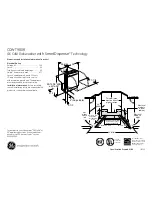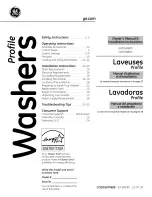
Loading the dishwasher
Scrape food and other solid waste
such as bones and pits from dishes,
but do not rinse.
Load the dishes so that water can
reach all surfaces.
Do not place dishes and cutlery in-
side other pieces where they may be
concealed.
Hollow items such as cups and
glasses should be inverted and
placed in the upper basket.
Concave based items should be
placed at an angle so that water can
run off them freely, or placed on top
of the coffee bar (see page 23).
Tall, narrow, hollow pieces should be
placed in the center of the basket,
rather than in the corners, to ensure
water coverage.
Small cups and glasses should be
placed on the cup racks. Taller mugs
and glasses can be placed under-
neath the rack.
The spray arms must not be blocked
by items which are too tall or hang
through the baskets. If in doubt, test
for free movement by manually rotat-
ing the spray arms.
Some food items may contain natural
dyes that can discolor plastic items
in the dishwasher ( e.g. carrots, to-
matoes, ketchup, etc.). The stability
of plastic items is not affected by this
discoloration. It will gradually disap-
pear over time.
Some loading examples are shown on
the following pages.
Note
If the additional feature “Top Solo” has
been selected with a wash programme,
all items must be loaded into the upper
basket and cutlery tray. See the “Addi-
tional features” section for further infor-
mation.
Do not touch the heating element
during or directly after the end of a
programme as it may still be hot.
In areas where the water has high
mineral content, it may be necess-
ary to polish silverware after wash-
ing to achive a high shine.
Loading the dishwasher
20
Summary of Contents for G 879 SCVI
Page 4: ...Guide to the appliance View of the machine Control panel 12 Guide to the appliance 4 ...
Page 47: ...Cutlery tray Comparison tests 47 ...
Page 48: ...48 ...
Page 49: ...Installation instructions 49 ...
Page 74: ...74 ...
Page 75: ...75 ...
















































